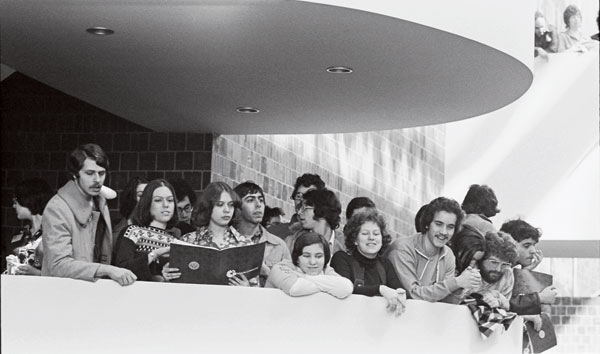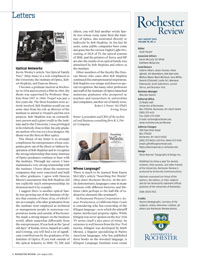Letters
Kevin Wesley’s article “An Optical Family Tree” (May-June) is a real compliment to the University, the Institute of Optics, Robert Hopkins, and Duncan Moore.
I became a graduate student at Rochester in 1954 and received a PhD in 1960. My thesis was supervised by Professor Hopkins from 1957 to 1960. Tropel was just a few years old. The three founders were actively involved. Bob Hopkins would cut out some time from his role as director of the institute to attend to Tropel’s and his own projects. Bob Hopkins was an extraordinary person and a giant credit to the institute and to the University. I was privileged to be relatively close to him, his only graduate student who was not a lens designer. My thesis was the first on fiber optics.
The thrust of my letter is to strongly compliment the entrepreneurs whose companies grew out of the direct or indirect inspiration of Bob Hopkins and to recognize the strong relationship that many Institute of Optics graduates continue to have with the institute. Through my career, I have maintained a very strong relationship with the institute. I knew about the numerous companies that were conceived and built by other graduates. I agree with Duncan Moore’s assessment that Bob Hopkins did not explicitly teach entrepreneurship; he demonstrated it by example.
I suggest there is another optical family tree growing out of the Institute of Optics that consists of those of us, of which I am an example, who after graduation from the institute were employed as technical or management people in numerous corporations inside and outside of Rochester. We made a strong impact on the business world, albeit somewhat differently from the entrepreneurs. If you look at the “good old days” of Kodak, Xerox, Bausch & Lomb, and Corning, you will find a lot of significant contributions by the graduates of the Institute of Optics. If you look outside of the optical industry, to IBM, TI, HP, and others, you will find another whole family tree whose roots came from the Institute of Optics, also motivated directly or indirectly by Bob Hopkins. In the last 50 years, some public companies have come and gone; but the current Digital Light Processing, or DLP, of TI, the optical systems of IBM, and the printers of Xerox and HP are also the results of an optical family tree stimulated by Bob Hopkins and others at the institute.
Other members of the faculty like Duncan Moore who came after Bob Hopkins continued this entrepreneurial inspiration. Bob Hopkins was unique and deserves special recognition. But many other professors and staff of the Institute of Optics launched numerous graduates who prospered as teachers and researchers in universities and companies, another set of family trees.
Robert J. Potter ’60 (PhD)
Irving, Texas
Potter is president and CEO of the technical and business consulting firm R. J. Potter Company.
Whose Language?
There is much to be learned from Karen McCally’s article “Searching For Words” (May-June) Rochester Review. As the article demonstrates, languages come in many versions with different histories and lifetimes (akin perhaps to the half-life of radioactive elements like uranium?).
In Paramount Pictures Corporation v. Axanar Productions, a California State Court is considering who has ownership of the Klingon language—as to which the plaintiff claims intellectual property rights. While Klingon was never spoken on the Star Trek TV series (itself a nice piece of trivia), its existence is well known from the Star Trek movies. Klingon was developed by Mark Okrand, a linguist specializing in Native American languages, who has published three books on the invented language. A Klingon Language Institute even exists to promote the language. A group called the Language Creation Society has filed a Friend of the Court brief to assist the defendant’s argument that copyright and intellectual property laws cannot be used to restrict the use of a spoken language—even if invented for a movie series. The brief cites a number of legal arguments and backs up those arguments with Klingon “proverbs.” You can’t make this stuff up. I wonder how to say “Meliora” in Klingon?
Paul Lester ’71
Coral Gables, Florida
I read the cover article of the May-June issue (“Searching for Words”) with interest. I work for SIL International, and one of my roles is as the registrar for newly identified languages around the world. Because of language identification issues, each language is issued a three-letter code to identify it. I process the requests for new codes for languages. Thank you for your interesting and informative article.
Melinda Lyons ’77
Dallas, Texas
 SHINE ON: Students bask in the sunlight that streams into the new Wilson Commons at its grand opening in April 1976. (Photo: University Libraries/Department of Rare Books, Special Collections, and Preservation)
SHINE ON: Students bask in the sunlight that streams into the new Wilson Commons at its grand opening in April 1976. (Photo: University Libraries/Department of Rare Books, Special Collections, and Preservation)Wilsonian Dreams and Nightmares
As a UR student from 1973 through 1977, I remember well the opening of Wilson Commons. To be frank, the construction period for Wilson Commons was not a great time to be at the University. In anticipation of being shut down when Wilson Commons opened, the old student union at Todd was clearly receiving no investment from the administration. Lower Todd was the only place on campus to get a drink or a snack, but the one time I opened the door to the place, I was almost sickened by the Stygian murkiness, noise, and smoke stench of the place.
Meanwhile, for several years there was a huge construction site virtually smack in the middle of campus. A popular graffiti on a wall next to the construction said (I may be paraphrasing): “The shortest distance between two points is the hole where Wilson Commons is.”
So I was looking forward to the opening of Wilson Commons near the end of my junior year. The festivities included a concert by the Duke Ellington Orchestra. Ellington had died a couple of years earlier, and his band had been taken over by his son, Mercer. The concert was held in a large, triangular-shaped room that was packed to the gills with students. Unfortunately, the acoustics in the room were so awful—the architects had obviously not consulted an acoustical engineer in designing it—that the music just reverberated from one wall to the next, and then back to the band, making it an unpleasant, echoing experience for everyone.
The acoustics of that room were just one of many kinks that needed to be worked out before Wilson Commons could really be the campus meeting place originally envisioned by the school (I assume after 40 years those kinks have been worked out). The innovative glass panes I. M. Pei was famous for (e.g., the West Wing of the National Gallery) had an unfortunate tendency to leak when it rained, and I don’t think anyone had really thought through how to wash them. The amount of glass in the atrium seemed to generate a tremendous amount of heat on sunny days (thankfully few in number, owing to Rochester’s wonderful climate) that made it seem like a sauna, and the ventilation system did not generate enough air circulation to ameliorate it. It was quite an experience to walk in from the frigid outside wearing a winter parka and immediately be thrust into a desert environment. The monumental dimensions of the atrium and the sparse, uncomfortable seating originally placed there made it seem forbidding and uninviting; I was there almost every day in my capacity as head of the UR Cinema Group and rarely saw any students seated there.
On the plus side, for the first time there was a real place to buy food during the day and evening, and a welcoming Rathskeller to replace the Dantean Circle of Hell that had been Lower Todd. Thanks for publishing the photo.
Brett Gold ’77
New York City
A Debate Over Debate
I wanted to send a comment about a letter by Sam Nelson about the Debate Union (Letters, May-June). The picture that is shown with the letter cannot be from the 1995–96 school year because I am in the picture. I graduated in 1991 and was well into grad school by the time the 1995 rolled around. I am on the bottom right-hand side of the image. Since the letter mentions that Sam was there from 1990 to 2005, I would guess that the picture is from the 1990–91 school year. I don’t think any of the people listed in the letter would be in that picture since their years of graduation are more than four years after the picture was taken.
Ken Wallace ’91
Potsdam, New York
Review welcomes letters and will print them as space permits. Letters may be edited for brevity and clarity. Unsigned letters cannot be used. Send letters to Rochester Review, 22 Wallis Hall, P.O. Box 270044, University of Rochester, Rochester, NY 14627-0044; rochrev@rochester.edu.

